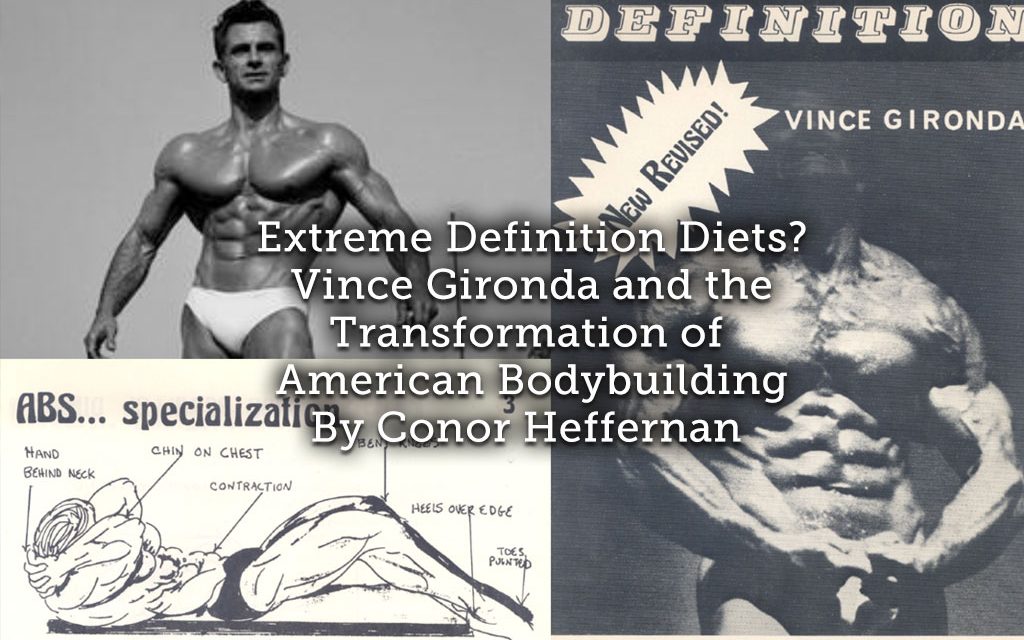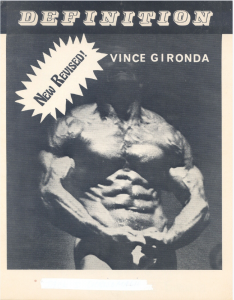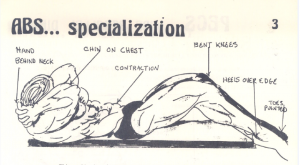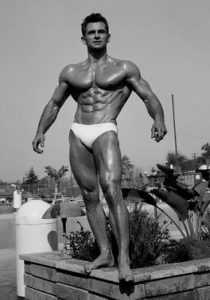Published in 1973 by the American weight trainer Vince Gironda, Definition: The New Revised Edition, promised readers increased muscle mass and visible abdominals within a relatively short period of time. First coming to the attention of the bodybuilding community as a competitor during the 1950s, Gironda, whose nickname was the ‘Iron Guru’, soon established himself as one of the leading coaches of late 1960s and 1970s. Found in popular magazines, newspapers and bodybuilding trainers, Gironda was famed for his broad appeal, counting bodybuilders, athletes, movie stars and members of the general public among his customers. It was this broad appeal which underpinned the importance of Gironda’s Definition book.
Contained alongside comments on different kinds of exercises which he himself had created, Gironda’s short pamphlet included his ‘definition diet’, said to produce dramatic weight loss results among users. At a time when fitness had begun to capture the American imagination, and the sport of bodybuilding was undergoing a shift towards increasingly unobtainable physiques, Gironda’s diet represented a new turn in bodybuilding. Owing, in part, to the influx of anabolic steroids within the sport, a trend which began in the late 1950s, Bodybuilders had begun to build more muscle and present much less bodyfat than ever before. In other words, bodybuilders were becoming more muscular and carrying less fat when they competed against when another. Individuals were becoming increasingly concerned with their body fat levels. For those competing, the lesser body fat one had, the greater their chances of winning. Gironda’s diet hoped to help users do just that.
- One of Gironda’s Accompanying Exercises
At a time when bodybuilders’ meal plans tended to be closely guarded secrets, written in remarkably vague passages, Gironda’s own diet was simple and specific. For breakfast, lunch and dinner, users were to consume an unlimited amount of eggs and meat, nothing more except for water and an occasional coffee. Coming after the first iteration of the Atkins’ Diet, published in 1972, Gironda’s meal plan, which was accompanied with a rather large number of nutritional supplements, was in effect a low carbohydrate, low calorie plan. Every four to five days, a small amount of carbohydrate was allowed in the form of one carbohydrate meal – say a salad or small bowl of rice – but outside of this window, no calories, including those found in fruit, were to be allowed.
Reprinted below, his diet demonstrates the lengths bodybuilders were willing to go to in order to win competitions. Furthermore it demonstrates, quite neatly, the influx of nutritional supplements into American life:
Breakfast
Eggs (No Limit)
- Scrambled in butter
- Poached
- Boiled, Soft or Hard
- Sunnyside up – in butter
Meat
- Hamburger Patty
- Pork Sausage Patty
- Steak
- Chops, Lamb or Pork
- Bacon
- Liver
- Chicken Livers
- Kidney
- Brains
Lunch
Same as breakfast
Dinner
Same as Breakfast and Lunch
- Roasts (all kinds)
Supplements
To be taken with each meal:
- 10 Liver Tablets or 2 tablets every hour
- 10 Kelp Tablets
- Beef Amino-Acids (1 oz.)
- 2 Enzyme Tablets
- 1 Iron Tablet (per day)
- 4 Calcium Tablets & 4 Before Retiring
- 1 Vitamin A Tablet
- 1 RNA Tablet
- 1 Niacin Tablet
- 1 Vitamin C Tablet every 4 hours (500mg.)
- 1 Vitamin E Tablet
- 1 Tablespoon Wheat Germ Oil (Cold Pressed)
- 3 Tri-Germ Oil Tablets
- Gironda during his Bodybuilding Career
The diet, deemed extreme even by its creator – he believed it caused nervousness – marked an increasingly common development in bodybuilding and American society more generally, namely, the extreme fat loss diet. The previous decade had witnessed a number of faddish, and some would say reckless, diets promoted by various individuals. Examples of this were Robert Cameron’s 1962 ‘steak and martini diet’, which was itself a low carbohydrate plan. Likewise, Dr. Atkin’s 1972 book was met with a great deal of derision by the medical community for its supposed unscientific nature. As the American public became increasingly interested in personal health, driven according to Shelly McKenzie by an increase in sedentary behaviours, purchasing power and moral panics surrounding heart disease, short terms and extreme diets had begun to be promoted.
In bodybuilding the extreme nature of such diets could be found in the ‘meat and water’ diet briefly promoted by Rheo H. Blair, an American nutritionist. The diet, which unsurprisingly consisted of just meat, was used promoted as a gruelling but effective way of shedding weight. Blair did not boast any medical credentials but this did not shot his diet being used by innumerable bodybuilders interested in shedding bodyfat before a competition or photoshoot. Blair, who counted Gironda among his friends, presented a more extreme diet than Gironda and it was perhaps for this reason that Gironda’s diet proved to the more popular of the two. According to Randy Roach, Gironda’s maximum definition diet became the de facto competition diet for bodybuilders during the 1960s and 1970s. His diet demonstrated the new lengths individuals were willing to go to in order to change their physiques.
Furthermore, Gironda, whose promotion of nutritional supplements was often unmatched, spoke of a new reliance in American society on nutritional supplements for health. Anabolic steroids had begun to influence the sport of bodybuilding but their effects were still largely disputed – Gironda himself believed a good diet was more powerful than performance enhancing drugs. His, and others, promotion of food supplements spoke of a much broader trend in American society which had begun to medicalise the diet. Far from a fringe diet, Gironda’s ‘definition diet’ took the American preoccupation with weight loss and supplementation to its natural conclusion.
A great deal of historical research needs to be done on the influx of fad diets and nutritional supplements in sport. Gironda’s diet, which continues to be used by members of the general public today, highlights the manner in which societal and sporting concerns often overlap when it comes to health. Furthermore, Gironda’s diet, coming at a time when high fatty foods were beginning to be demonized by the medical community, shows the often subversive and reckless nature of fat loss diets. Read by bodybuilders and the lay public, the ‘Definition Diet’ was both popular and particular. It appealed to many but required a great deal of ascetism and pseudo-medicalization. That a quick Google search reveals its continued popularity suggests that the motivations underpinning this diet have not gone away, but rather intensified.
Article © Conor Heffernan
Further Reading
Gironda, Vince, Definition: New Revision (Self Published, 1973).
McKenzie, Shelly, Getting Physical: The Rise of Fitness Culture in America (Kansas, 2013).
Roach, Randy, Muscle, Smoke, and Mirrors. Vol. I (AuthorHouse, 2008).









good job, Connor. Gironda lives on via your results and testimony.